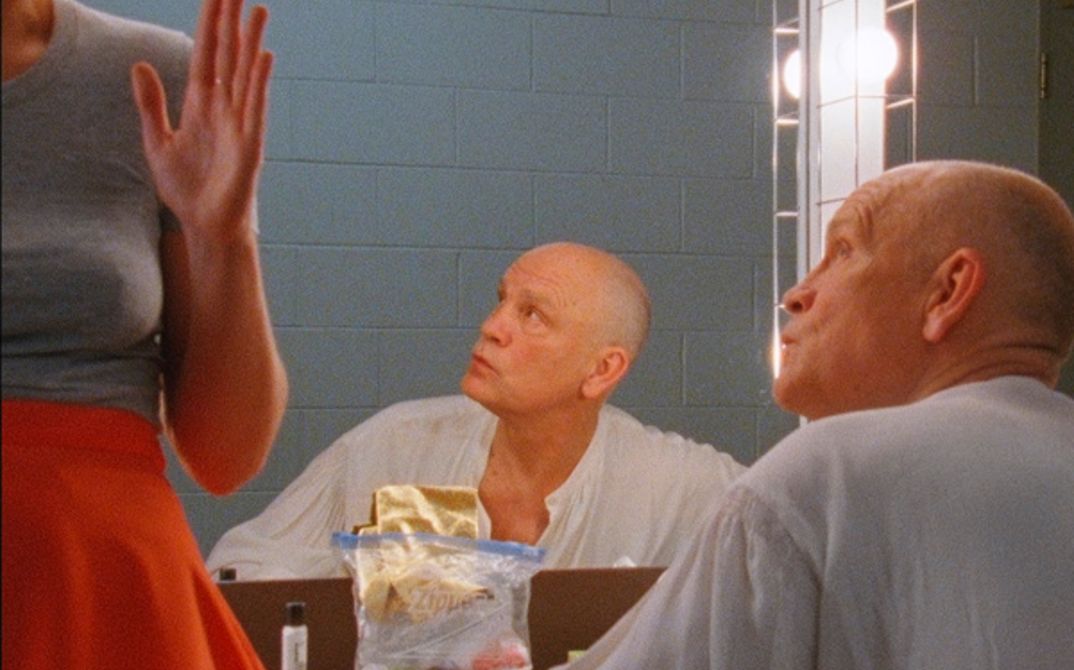Conversation with Luise Donschen: “The mating dance of the finches was a pleasure to watch”
Adnan Softić: In the first shot in CASANOVAGEN, a person dressed as a flamingo enters a scene clearly located in Venice; photographers and tourists successively move between the camera and the person until the flamingo vanishes. Everything seems choreographed; even the tourists seem to know what is to be done. Why do you begin the film with this shot?
Luise Donschen: This shot contains much that reappears later in the film. The appearance you mention is important, as is the ritual character in the sequence: the disguise, the pleasurable movement, the shifting between genders. A great beauty and simultaneously something very profane lies in all this.
The film also offers glimpses into ornithology: the male finch chases the female back and forth in a cage. A scientist observes this on her computer. The image, but above all the sounds that the birds thereby make, strongly remind me of a simply designed video game in which you collect points by hopping around.
The starting-point for the film was a newspaper article about finches. It was about the female finch and how what is called the ‘Casanova gene’ makes it promiscuous. This gene was described as the genetic collateral damage of the male’s polygamy, which has an evolutionary advantage. I found this extremely conservative approach in the modern guise of genetics very interesting, and I drove to the Max Planck Institute for Ornithology in Seewiesen in Upper Bavaria. Against my expectations, I immediately liked the place, these premises in the middle of the forest. I liked the seriousness and calmness with which the people there worked. The mating dance of the finches was a pleasure to watch, and I soon learned to distinguish the female from the male, based on her song. The finches and the scientists researching them shifted me from thinking to watching and listening. I took up this shift again when editing.
You appear in the film yourself, as a filmmaker, but not as a detached one. What was your relationship with the protagonists?
The separation between the actor and the person behind him is important to me. The actor protects the person, and I always paid attention to which side of the boundary I was moving on. That’s why it was good that the first shot we ever took for the film was the scene with John Malkovich, in which I also act. The experience of showing myself and the concreteness of the material then accompanied me throughout the shooting. I can protect the people only until the end of shooting; after that, they are figures and as stubbornly inevitable as the material.
On the other hand, we observe Undine. She cultivates sadomasochism as a sex drive and an offer of services. Why did you do without explicit, hard-core scenes?
I watched many sessions with Undine in the studio, and most of them alienated me. But from the beginning, I was fascinated by her soft voice and ability to take everyone who came to her as he was. So starting from there, together we conceived the session seen in the film.
In CASANOVAGEN, the Jesus figure of Christianity also plays a role as an incomprehensible, bodiless object of desire. What is notable in this episode is that you abandon the role of observer and become a participant yourself, thereby addressing your relationship to the priest. Together you look at a painting of flowers, and suddenly you embrace him.
In the Kunsthalle, I tried to use just a few shots to characterise our relationship. What constitutes it is that both of us remain entirely ourselves. Elija is a monk. He believes. I don’t believe. If we tried to be like one another, our relationship would collapse. That’s why some themes can be treated only indirectly – for example, via art. And yet, we feel close to one another. The images I found for that are now in the film.
The episodes are tied together in a quiet way. The protagonists don’t talk about themselves, and you don’t use a voice-over, either. You stage each scene in its own particular way. It must have been quite a challenge to give the film a rhythm and structure.
The editing was complicated. I spent five years writing, shooting and editing, over and over again. The last shoot was in early summer of 2017. I definitely wanted to avoid ultimately having to use interviews or voice-overs to give the film cohesion, and that’s why I very gently tried to create other connections in the material. I worked with certain motifs, with motion, with clothing. While editing, I had to detach myself from these connections again and get a feeling for the film as such. That’s why I edited in a non-linear way, working from ‘islands’.
CASANOVAGEN was produced with very meagre means. Nonetheless, you decided to use Super-16-mm film material. Why?
I placed certain constraints on myself and accepted others that were externally imposed. The scene with John Malkovich was the first we shot for the film. To get him to agree, I had decided to film the conversation in one shot. So John Malkovich came off stage after his performance and we shot our conversation within eleven minutes – that’s the length of a roll of 16mm film material. Then he changed clothes and left the dressing room. I experienced this constraint as a liberation that made it easier for me to concentrate on my simultaneous work as director and actress. Based on the conditions in the dressing room where we shot the scene, and on the visual composition at the beginning of the scene, cinematographer Helena Wittmann and I decided to shoot in the 16:9 format. That determined material and format.
(Interview: Adnan Softić, editor: Sabine Boshamer, January 2018)
